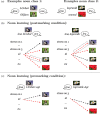Order Matters! Influences of Linear Order on Linguistic Category Learning
- PMID: 33124103
- PMCID: PMC7685149
- DOI: 10.1111/cogs.12910
Order Matters! Influences of Linear Order on Linguistic Category Learning
Abstract
Linguistic category learning has been shown to be highly sensitive to linear order, and depending on the task, differentially sensitive to the information provided by preceding category markers (premarkers, e.g., gendered articles) or succeeding category markers (postmarkers, e.g., gendered suffixes). Given that numerous systems for marking grammatical categories exist in natural languages, it follows that a better understanding of these findings can shed light on the factors underlying this diversity. In two discriminative learning simulations and an artificial language learning experiment, we identify two factors that modulate linear order effects in linguistic category learning: category structure and the level of abstraction in a category hierarchy. Regarding category structure, we find that postmarking brings an advantage for learning category diagnostic stimulus dimensions, an effect not present when categories are non-confusable. Regarding levels of abstraction, we find that premarking of super-ordinate categories (e.g., noun class) facilitates learning of subordinate categories (e.g., nouns). We present detailed simulations using a plausible candidate mechanism for the observed effects, along with a comprehensive analysis of linear order effects within an expectation-based account of learning. Our findings indicate that linguistic category learning is differentially guided by pre- and postmarking, and that the influence of each is modulated by the specific characteristics of a given category system.
Keywords: Artificial language learning experiment; Behavioral experiment; Computational simulation; Discriminative learning; Error-driven learning; Linguistic categories.
© 2020 The Authors. Cognitive Science published by Wiley Periodicals LLC on behalf of Cognitive Science Society (CSS).
Figures









Similar articles
-
Category Clustering and Morphological Learning.Cogn Sci. 2022 Feb;46(2):e13107. doi: 10.1111/cogs.13107. Cogn Sci. 2022. PMID: 35166378 Free PMC article.
-
A cross-linguistic examination of the noun-category bias: its existence and specificity in French- and Spanish-speaking preschool-aged children.Cogn Psychol. 1997 Apr;32(3):183-218. doi: 10.1006/cogp.1997.0650. Cogn Psychol. 1997. PMID: 9125905
-
A Linguistic-Sensorimotor Model of the Basic-Level Advantage in Category Verification.Cogn Sci. 2024 Dec;48(12):e70025. doi: 10.1111/cogs.70025. Cogn Sci. 2024. PMID: 39715230 Free PMC article.
-
How does linguistic context influence word learning?J Child Lang. 2023 Nov;50(6):1374-1393. doi: 10.1017/S0305000923000302. Epub 2023 Jun 20. J Child Lang. 2023. PMID: 37337944 Review.
-
Statistical evidence that a child can create a combinatorial linguistic system without external linguistic input: Implications for language evolution.Neurosci Biobehav Rev. 2017 Oct;81(Pt B):150-157. doi: 10.1016/j.neubiorev.2016.12.016. Epub 2016 Dec 29. Neurosci Biobehav Rev. 2017. PMID: 28041786 Free PMC article. Review.
Cited by
-
An exploration of error-driven learning in simple two-layer networks from a discriminative learning perspective.Behav Res Methods. 2022 Oct;54(5):2221-2251. doi: 10.3758/s13428-021-01711-5. Epub 2022 Jan 14. Behav Res Methods. 2022. PMID: 35032022 Free PMC article.
-
Understanding the Phonetic Characteristics of Speech Under Uncertainty-Implications of the Representation of Linguistic Knowledge in Learning and Processing.Front Psychol. 2022 Apr 25;13:754395. doi: 10.3389/fpsyg.2022.754395. eCollection 2022. Front Psychol. 2022. PMID: 35548492 Free PMC article.
-
Prediction and error in early infant speech learning: A speech acquisition model.Cognition. 2021 Jul;212:104697. doi: 10.1016/j.cognition.2021.104697. Epub 2021 Mar 31. Cognition. 2021. PMID: 33798952 Free PMC article.
-
Dialects, motivation, and English proficiency: Empirical evidence from China.Front Psychol. 2022 Sep 29;13:999345. doi: 10.3389/fpsyg.2022.999345. eCollection 2022. Front Psychol. 2022. PMID: 36248592 Free PMC article.
-
Affixation patterns in native language and sequence processing by statistical learning mechanisms.Evol Hum Sci. 2025 Feb 14;7:e11. doi: 10.1017/ehs.2025.6. eCollection 2025. Evol Hum Sci. 2025. PMID: 40027139 Free PMC article.
References
-
- Aizenberg, I. , Aizenberg, N. N. , & Vandewalle, J. P. (2013). Multi‐valued and universal binary neurons: Theory, learning and applications. Dordrecht, The Netherlands: Springer Science & Business Media.
-
- Akaike, H. (2011). Akaike's information criterion In Lovric M. (Ed.), International encyclopedia of statistical science (p. 25). Berlin/Heidelberg: Springer.
-
- Arnon, I. , & Ramscar, M. (2012). Granularity and the acquisition of grammatical gender: How order‐of‐acquisition affects what gets learned. Cognition, 122(3), 292–305. - PubMed
-
- Arppe, A. , Hendrix, P. , Milin, P. , Baayen, R. H. , Sering, T. , & Shaoul, C. (2018). ndl: Naive discriminative learning. R package version 0.2.18. Available at: https://CRAN.R‐project.org/package=ndl. Accessed September 28, 2020.
-
- Boersma, P. , & Escudero, P. (2008). Learning to perceive a smaller L2 vowel inventory: An optimality theory account In Avery P., Dresher B. E. & Rice K. (Eds.), Contrast in phonology: Theory, perception, acquisition (pp. 271–301). Berlin: Mouton de Gruyter.
Publication types
MeSH terms
LinkOut - more resources
Full Text Sources

